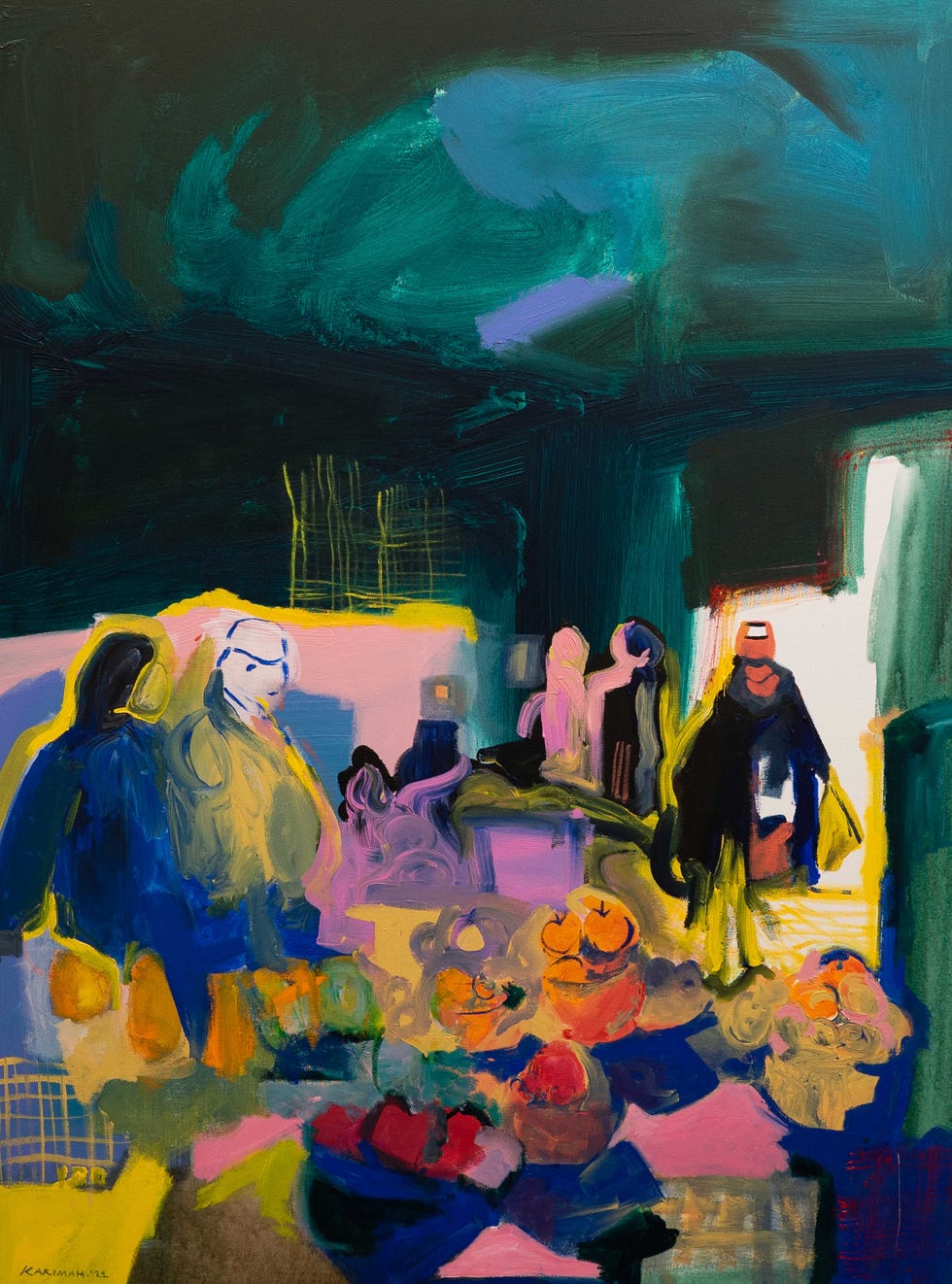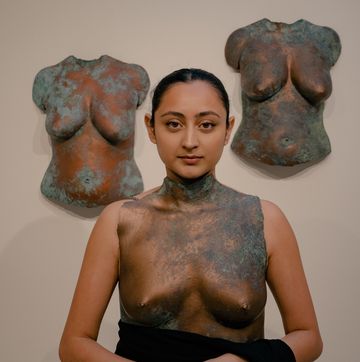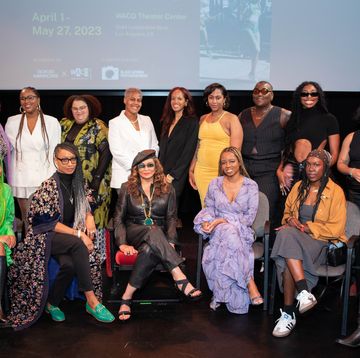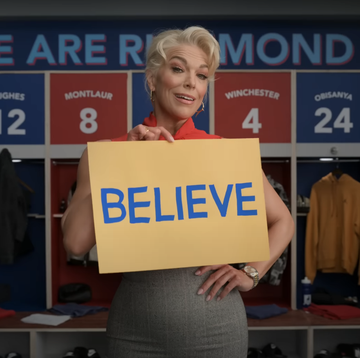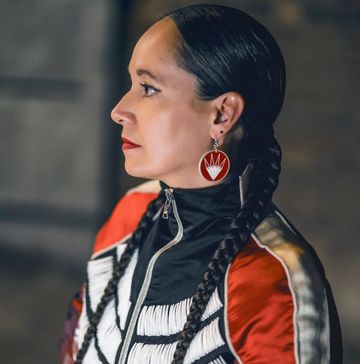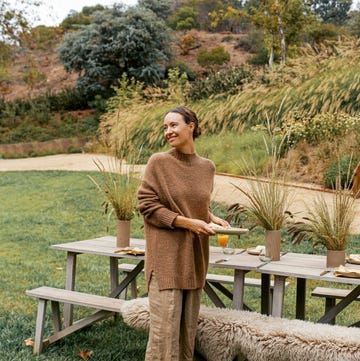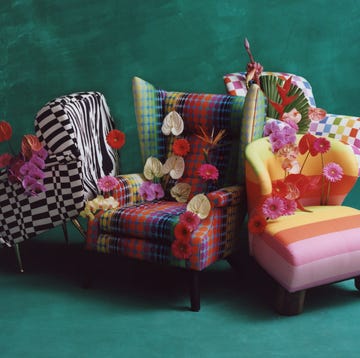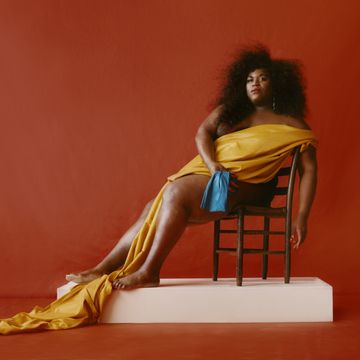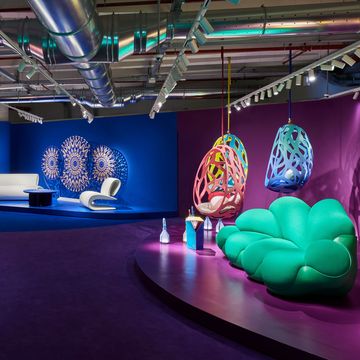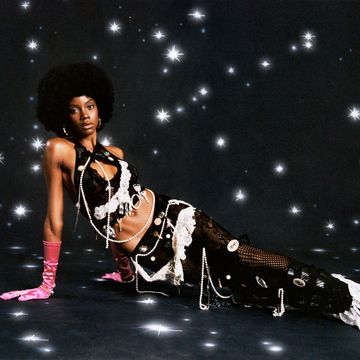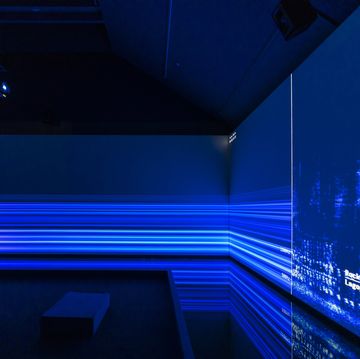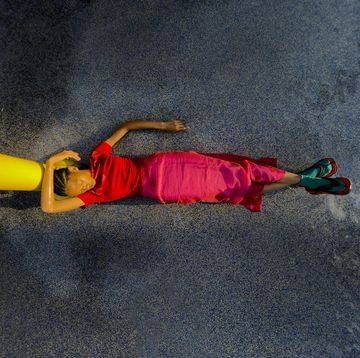Whether you're looking to add to your collection, or just take in some local culture, a vacation timed to an international art fair promises breathtaking views. Read on to learn where to stay and what to see at three international art fairs this fall.
NEW YORK
THE ARMORY SHOW
September 9–11
Javits Center
Since its inception in 1994, New York’s Armory Show has established itself as a can’t-miss event on the city’s cultural calendar, reaching far beyond the Javits Center’s iconic glass walls to share the latest in global art. This year boasts the addition of three curators—Tobias Ostrander, Carla Acevedo-Yates, and Mari Carmen Ramírez—all of whom have expertise in the field of Latin American and Latinx art. “New York has such a strong Latino population, and it’s really important for us to have an area that’s focused on what’s being created and the community around it,” explains executive director Nicole Berry. “It’s the first time we’ve done this.”
More From ELLE

Also new: As part of the Armory Off-Site initiative, which places public art in various locations around the city, the fair has partnered with the United States Tennis Association to present several large-scale sculptures on the grounds of the US Open. “We call ourselves New York’s fair and we really feel that,” Berry says. “We want to embrace the city, we want to support the city, and we want to engage with the cultural institutions that make this city great.”
THE PHOTOGRAPHER: Nona Faustine
New York, for all its bluster and glitz, is also a city of ghosts. It’s easy to ignore them—to get caught up in the swirl of what’s new—but every so often, on an empty cobblestoned street or in a darkened stairwell, you might feel their pull. They’ve been tugging at Brooklyn-born photographer Nona Faustine since she was a girl. She’d explore the city with her mother, running errands, wondering about who came before her. “I was always asking about the past, thinking about past New Yorkers,” she explains. But as she pursued an undergraduate degree at the School of Visual Arts, then a master of fine arts from the International Center of Photography (ICP)–Bard College program, she noticed that the city’s history as a slave trade capital was rarely mentioned, and that people who looked like her—“plus-size, dark skin”—were rarely depicted in museums or galleries. “I wanted to address that gap.”
So, 10 years ago, Faustine embarked on a project born more out of passion than anything else: a series of large-format self-portraits taken in front of the city’s less heralded spots—the sites of slave auctions, an African burial ground, the ports where slave ships once docked. In many of the images, she’s nude, save for a pair of white, high-heeled shoes. She appears vulnerable yet defiant, a stand-in for the forgotten. “It goes to a larger question about African American contributions,” she explains. “The unacknowledged voices; what’s been erased.”
Now that project, aptly titled White Shoes, will be presented at Higher Pictures Generation during New York’s Armory Show. Though the series has garnered considerable acclaim over the last decade—several of the original works are included in permanent museum collections, and an eponymous book was released last year—this is the first time that dozens of new, never-before-seen pieces will be shown, allowing viewers to fully absorb the force of Faustine’s seminal oeuvre. It’s a milestone she doesn’t take lightly, especially given the personal nature of the work. “It came from the purest, most from-the-soul expression, and that’s not always easy to share with the world,” she says. “It was my way of dealing with the sorrow and the horror and the complexity of our history here in America. To have people embrace it the way they have, it’s just incredible.”
WHILE IN NEW YORK...
Where to Stay: The Hotel Chelsea
After being closed to bookings for over a decade, the iconic Victorian Gothic landmark—once home to Bob Dylan, Patti Smith, Janis Joplin, and more—has recently reopened with a spruced-up look that honors its storied past. hotelchelsea.com
Pendry Manhattan West
This elegant newcomer features contemporary California-meets-midcentury common areas and guest rooms designed by Gachot Studios as well as stunning Manhattan views and plenty of convivial public spaces, including an always-buzzing-at-happy-hour lobby bar. pendry.com
Where to Shop: Otras Formas
Designer Alex Lithgow’s sculptural sofas, tables, and chairs come to life in this airy new Flatiron showroom, along with a carefully curated selection of modern lighting, furniture, and artwork from emerging and established designers. otrasformas.co
Roman and Williams Guild
Design firm Roman and Williams has created some of the city’s most iconic interiors, from The Boom Boom Room, aka Top of The Standard, to Le Coucou. Its SoHo emporium puts its eclectic-opulent perspective on full display with globally sourced objects and art, original furniture, a flower shop, and a modern French restaurant. rwguild.com
What Else to See : Virgil Abloh: “Figures of Speech”
The first museum exhibition dedicated to the late fashion designer and former Louis Vuitton menswear creative director lands at the Brooklyn Museum with a mix of large-scale installations, sculpture, and two decades’ worth of never-before-seen fashion, sketches, journals, and videos. brooklynmuseum.org
LONDON
FRIEZE
October 12-16
The Regent’s Park
With several publications and fairs in four cities, including New York, Seoul, and Los Angeles, Frieze is a contemporary art powerhouse. But Frieze London is the brand’s signature and best-known in-person show. Not just because it’s the largest—in recent years, 60,000 visitors have attended Frieze London and its sister fair, Frieze Masters, annually—but because The Big Smoke is where it all began.
“London is our hometown,” says artistic director Eva Langret. “We always look to work with the artists, galleries, museums, and wider cultural networks that make this city unlike any other.” To that end, there’ll be plenty of satellite events and exhibits sprinkled across the city’s galleries, restaurants, hotels, and museums. This year’s Frieze Artist Award commission features an interactive, site-specific installation by London-based artist Abbas Zahedi adjacent to the entrance to the show’s main space.
Meanwhile, Sandhini Poddar, adjunct curator of Guggenheim Abu Dhabi Project, has been tapped for a special section centered on “interconnectedness and interdependence,” showcasing work from galleries in Sri Lanka, the Philippines, Chile, Mexico, India, the U.S., and the UK. “There is so much to see, I recommend coming with a couple of things in mind that you absolutely want to look at,” Langret says. “But also, let your eye wander.”
THE PAINTER: Karimah Hassan
What does a painted portrait evoke? An essence, an energy, a mood? For London-based artist Karimah Hassan, “It’s about the feeling—the feeling it leaves in your gut. My work captures how it is to be in the moment.”
Being in the moment is important to Hassan. And not just as a way to explore her many creative pursuits—she works on everything from lino prints to spoken-word poetry to NFTs—but as a way to build connections, too. Raised in Newport, South Wales, by a Yemeni-Welsh father and Bangladeshi mother, she often felt like an outsider. While studying architecture in London at the Royal College of Art, she painted her performer friends as they rehearsed. Later, in New York City, she drew dancers as a way to get to know communities with whom she found resonance. “When I went back to London, it became my mission to show people that there can be spaces where they belong.” She started hosting live showcases across the city, inviting dancers, musicians, and poets to perform. She painted alongside them in real time, capturing “the spirit of the night,” she says. “It was a way for me to nod toward other communities. It came from that feeling of loneliness.”
Now, eight years on, she says she’s far from that feeling. Not only does she have the support of the diverse community she’s cultivated, but since fall 2020 she’s been an artist in residence at the prestigious Sarabande Foundation, the legacy of late fashion designer Alexander McQueen. Her work has also been commissioned by a host of big names: Ted Baker, The High Line New York, and Arts Council England, to name a few.
But Hassan still empathizes with the sense of isolation that modern life can bring. It’s one of the reasons that, during the height of the UK’s first long lockdown, she started soliciting selfies on Instagram from which to paint. The resulting series, titled The Strangers Yearbook, has since been turned into a coffee-table book, and a selection of the prints are on permanent public display at Coal Drops Yard in King’s Cross. It’s all part of Hassan’s ongoing mission to use art as an instrument to connect. “As artists, our role is to express things that people can’t necessarily say. I’m working to create art that makes you feel like you’re in an oasis, like you’re safe. I love when people feel a deep sense of being seen.”
WHILE IN LONDON...
Where to Stay: Beaverbrook Town House
Toward the end of Chelsea’s tony Sloane Street, a pair of Georgian homes have been turned into a charming jewel-box hotel inspired by the golden era of London’s West End. Each velvet-adorned suite features vintage art prints and is named after an iconic city theater. beaverbrooktownhouse .co.uk
Mayfair may be known for posh eateries and exclusive clubs, but this buzzy new hotel doesn’t take itself too seriously. Catering to the “creative and the curious,” its playful take on 18th- century French decor includes a leopard-print staircase leading to The Music Room, open to members and hotel guests for late-night dancing.
The Twenty Two
the22.london
Where to Shop: Balenciaga
From the outside, the label’s new flagship fits right in with all the other luxury stores on Bond Street. But inside, it’s another story entirely, with intentionally exposed wires, cracked concrete, rusted pipes, and plenty of other derelict surprises spread across three floors.balenciaga.com
Koibird
With an eye-popping assortment of clothing, accessories, and homewares from designers such as Cult Gaia, Sandra Mansour, and Upstate, this Marylebone concept shop delivers on its promise of “never boring.” In-store vignettes are meant to evoke far-flung locales, while the exterior is repainted each season to reflect the overall theme. koibird.com
What Else to See: Fashioning Masculinities: The Art of Menswear
The V&A’s latest exhibit juxtaposes around 200 works of fashion and art to explore how the concept of masculinity has shifted throughout the course of history—and how fashion designers continue to push the boundaries of gender identity today. vam.ac.uk
BOGOTÁ
ARTBO
October 27–30
Corferias Centro de Convenciones
Perched nearly 9,000 feet above sea level on a majestic Andean plateau, Bogotá has always had a singular energy. Often called Colombia’s melting pot, it’s both the capital and the cultural epicenter, a place where the country’s rich history and diverse population converge. Nowhere is that felt more than in its arts scene, comprising an impassioned community of traditional artisans and forward-thinking creatives.
In the fall, things reach a fever pitch when ARTBO, now in its 18th year, explodes across the city to share the work of hundreds of artists. “What happens during that week is just incredible in terms of all of the different activities,” explains Tatiana Rais, cofounder and director of Espacio Odeón, a multidisciplinary space that’s become an integral incubator and hub for the city’s arts community. But for all its bustle and buzz, Rais says what really sets ARTBO apart from other fairs is its focus on homegrown talent. “It’s an art fair that offers an alternative perspective—it’s an amalgamation of all the projects that are already going on here throughout the year.”
THE PHOTOGRAPHER: Karen Paulina Biswell
In Spanish, the word inframundo has two meanings. It can point to the mystical, a netherworld where spirits roam. Or it can refer to a group that’s been marginalized or displaced. Both convey what’s in the shadows—the in-between. Photographer Karen Paulina Biswell has lived her life in between. Born in Aruba to Colombian parents, and eventually landing in France to escape political upheaval in the 1990s, Biswell later moved to Bogotá as a teenager. Now, after studying art history at the Sorbonne, and a stint in London, she splits her time between Paris and Bogotá.
“There is an emergency in Colombia—un urgencia,” she emphasizes. The country, like so many others, has been hit hard by the pandemic, climate change, political strife, and growing socioeconomic divides. “There are a lot of questions in Colombia—questions about history, about our relationship with certain communities. It’s not the time to run away. It’s a moment to go back and create.” Biswell’s work, which explores “vulnerability, morality, and fate,” toes the line between documentary and dream. Though she says her work is “autobiographical,” she rarely appears in the frame. Instead, she shoots other people, mostly women. She sees it as a collaboration. “I don’t want them to be my subject; I want to be sharing a point of view with them.”
Lately, she’s been interested in sharing a point of view with the Indigenous Emberá Chamí tribe, who have been increasingly forced from their lands. One portrait series, Nama Bu (titled We Exist in English), sets her lens on a displaced family she befriended on the streets of Bogotá. Another, Kima, or Unity—a selection of which will be shown at Instituto de Visión during ARTBO—is a collaboration with María Amilbia Siagama Siagama, an Emberá Chamí creative she met through that same family. Together, the two women have created a mixed-media collection inspired by the datura flower, traditionally used by Indigenous jaibanás to access another view of things—to see the inframundo. “It’s about how we can unite our different languages,” Biswell says of the work. “She has her own language; I have mine. We are saying the same things, but in a different way.”
While Biswell hopes such projects inspire empathy, she doesn’t claim to have all the solutions—she’s just trying to make space for them to show up. “Photography is a window that you open. I don’t want to give the answer; I want to give people questions.” Because for Biswell, the most important question is often this: “When did you become aware?”
WHILE IN BOGOTÁ ...
Where to Stay: Casa Legado
Housed in an airy midcentury building in the quaint Quinta Camacho neighborhood, this photogenic 13-room bed-and-breakfast is filled with the kinds of personal touches—delicate floral wallpaper, antique wood furniture, handpicked local finds—that make it feel like a stylish friend’s home. casalegadobogota.com
Four Seasons Hotel Casa Medina
While located in the bustling gastronomic and financial district of Zona G, it’s considered one of the city’s most serene and stylish stays. This landmark 1946 building, designed by Colombian-born architect Santiago Medina Mejía, retains much of its original charm with hand-carved wood ceiling beams and wood-burning fireplaces. fourseasons.com
Where to Shop: Artesanías de Colombia
You’ll want to take home absolutely everything in this gallery-like online shop filled with sculptural terra-cotta pottery, handwoven baskets, knotted hammocks, and more, made by artisans around the country. As part of a larger fair-trade government organization that promotes traditional handicrafts, artisans receive 100 percent of the price they set for their items. An English-language version of the site is in the works. artesaniasdecolombiatienda .com.co
Nada
There’s always a crowd of creatives at this indie publishing house and bookshop tucked in the hills of the hip Quinta Camacho neighborhood. Not only is it the place to stock up on rare art tomes from Colombia and abroad, but it also hosts regular readings, talks, and exhibits featuring local and international artists. nada.com.co
What Else to See: Instituto de Visión
With public art exhibits centered on everything from queer theory to the impact of displacement, this women-run conceptual gallery in the San Felipe neighborhood shines an all-important light on the once-forgotten disciplines of Latin America as well as the work of the country’s most innovative emerging artists. The gallery has a second location in New York’s Lower East Side. institutodevision.com
MIAMI BEACH
ART BASEL
December 1–3
Miami Beach Convention Center
Art Basel Miami Beach may be one of the United States’ most famous—and infamous—art fairs, but don’t let its reputation for over-the-top events fool you; the show is still as revered in the art world as ever. Not only does it draw more than 250 galleries in an eye-popping display showcasing the work of thousands of international artists, it’s become a driving force in Miami’s own burgeoning art community—which includes many Latin American artists—as well. “
Art Basel Miami Beach has its own unique way of bridging the art scene of South America with North America, Europe, and beyond,” says Amalia Amoedo, an Argentinian art collector, whose interdisciplinary artist residency program in José Ignacio, Uraguay, Fundación Ama Amoedo Residencia Artística (FAARA), will partner with Miami Art Week this year to offer a platform for emerging artists from the program. “With each edition, there’s wider and more diverse representation, both within the fair and in the satellite activities during that week.”
Those activities include offerings from many of South Florida’s cultural institutions, such as the Pérez Art Museum; Institute of Contemporary Art, Miami; Rubell Museum; Locust Projects; and more. “The city has undergone such an outstanding transformation over the years—the confluence of outstanding contemporary art and amazing artists and art professionals in the same place is a boost of energy.”
THE MULTIDISCIPLINARY ARTIST: Cristina Lei Rodriguez
Wild jumbles of neon blooms, blades of grass, and blurred, sunset hues. Miami-born artist Cristina Lei Rodriguez’s large-scale installations feel a bit like peering into a psychedelic garden. Or like pressing Pause during a Technicolor nature doc. Her work is vibrant and organic, but surreal and synthetic-looking, too. Which is exactly the point. Raised by a Cuban father and a Japanese-American mother in a place that’s known for both raw beauty and splashy diversions, Rodriguez has gained a certain appreciation for juxtapositions. “There’s a tension between what is natural and what is artificial,” she says of both Miami and her artwork. “I think that duality is really interesting. It’s part of what defines our city.”
To capture it, she creates digitized images using whatever she has: orchids grown by her father, or leaves, plants, seeds, and flowers plucked from her own native garden. Outside, in the South Florida predawn or dusk, she arranges them into collages, letting her high-res scanner’s long exposure capture the sun’s shifting light. And then she sits back and hopes that a happy accident—maybe a technological stutter or gust of wind—might occur, rearranging the composition or causing a graphic smear. “I’m interested in chance,” she explains. “Our world exists with so much complexity and contradiction. A lot of times, we feel pressure to make it simple, but it’s not. I like for my work to be accepting of that.”
It’s a philosophy that’s struck a chord. This year, she’s been commissioned to create two highly visible public works: Homegrown, a tiled mural outside the Westchester Cultural Arts Center at Tropical Park, and a translucent window installation at Miami International Airport. That’s on top of her already well-known endeavors, like 2020’s Digitizing the Phenomena of Nature (Orchids at Sunrise), a reflective print fused to the top-floor windows of the Design District’s Reiulf Ramstad Arkitekter building, Sweetbird; and Staging a Florida Sunset, a translucent digital vinyl print that adorned Locust Projects’ exterior window during Miami Art Week last year.
Rodriguez hopes her public projects become part of the city’s geography, like two-dimensional parks. “Nature’s always been a place for me to get inspiration, a space to think,” she explains. “I really want my work to be a landscape from which to take what you need. I like that as you live with the work—as you walk by it every day—there’s so much going on that you can get lost in it.”
WHILE IN MIAMI ...
Where to Stay: Esmé
Manhattan-based interior designer Jessica Schuster reimagined the buildings of a 1920s-era artist colony into a 145-room boutique hotel complete with arched doorways, fireplaces, and a fantastical citrus-and-jewel-toned palette that hits the perfect balance between old world and new. esmehotel.com
Life House
The South of Fifth neighborhood is now one of Miami Beach’s most desirable, but 100 years ago it was a vibrant artist colony. This newly refurbished 1930s cottage pays homage to the neighborhood’s roots with 26 understated guest rooms inspired by artist bedrooms. lifehousehotels.com
Where to Shop: Mrs. Mandolin
Miami tastemaker Anastasia Koutsioukis’s understated globe-trotter style has gained a cult following thanks to the popularity of her chic, Aegean-inspired taverna in the Design District. Open to members and guests, her Soho Beach House boutique, with its covetable curation of elegant beachwear and refined apothecary items, cements her local-legend status. mrsmandolin.com
Upper Buena Vista
This modern bohemian market features a city block’s worth of micro boutiques and innovative eateries in a lush outdoor setting centered around a 120-year-old banyan tree. upperbuenavista.com
What Else to See: Vizcaya Museum & Gardens
Built in 1916 to mimic a jaw-dropping Italian Renaissance estate, this landmark villa is nestled among a 10-acre waterfront garden that calls to mind a tropical Versailles. Inside the 34 rooms, further wonders abound—gilded panels, frescoed ceilings, and centuries-old art. vizcaya.org
This article appears in the September 2022 issue of ELLE.
Christina Pérez is a freelance writer covering people, places, ideas, and things. Her work has appeared in Vogue, GQ, Harper's Bazaar, and many more.
